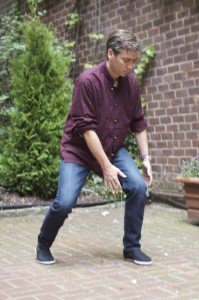 Stability and flow seem to be at odds with each other. Stability can mean rigidity, or at least, it seems to conjure up something fixed, sturdy, and unmoving. Flow isn't any of those things. It's fluid and changing. So how does Energy Arts Senior Instructor Craig Barnes blend the two so seamlessly?
Stability and flow seem to be at odds with each other. Stability can mean rigidity, or at least, it seems to conjure up something fixed, sturdy, and unmoving. Flow isn't any of those things. It's fluid and changing. So how does Energy Arts Senior Instructor Craig Barnes blend the two so seamlessly?
Recently, Craig taught a workshop about awakening energetic sensitivity, drawn from principles of Dragon and Tiger Qigong. We worked a lot on the opening of the set. The goal was to "fill up your chi" before you start doing the movements, so that the body is awake and engaged and each movement is more alive and more connected.
The specific method for waking up your energetic sensitivity begins with refining awareness of your physical body. How do you move each part under conscious control, in a smooth circular way? Craig is very skilled at leading a group through a gradual progression that brings each new piece online and then weaves it together with the previous pieces.
What impressed me more, though, was the way he included "stability points", while maintaining the flow of the teaching, which was also what he was teaching people to do in their practice.
Perhaps "stability point" is the wrong term. Certainly this was a "point" in time in the flow of practice, but what Craig teaches, as far as stabilizing the mind, has a more diffuse quality than "point" conveys. You miss it if you focus on all the little details of body mechanics. If you treat the components of your practice like a checklist, you never become internally connected.
Stability of the mind, when Craig expresses it, becomes the ground for your practice. A stable mind is like a table, set for a great meal. The specific exercises are the plates and bowls and cups that get filled up with delicious food, but you need to set the table for the meal to come together.
 Internalizing the paradox of stability and flow goes a step or two beyond "setting the table", though. Dragon and Tiger is a great place to learn how to stabilize the mind in the flow of movements because, between each distinct movement pattern, there are transitional moves that you can repeat as much as you need to. In these transitions, it's much easier to return to stability, but you don't have to break the flow. You do something simple, like circle the arms back and forth around the waist, or pulse the hands in and out, which keeps up a smooth flow. Through the simple repetition, your mind can settle down again at the same time.
Internalizing the paradox of stability and flow goes a step or two beyond "setting the table", though. Dragon and Tiger is a great place to learn how to stabilize the mind in the flow of movements because, between each distinct movement pattern, there are transitional moves that you can repeat as much as you need to. In these transitions, it's much easier to return to stability, but you don't have to break the flow. You do something simple, like circle the arms back and forth around the waist, or pulse the hands in and out, which keeps up a smooth flow. Through the simple repetition, your mind can settle down again at the same time.
While Dragon and Tiger is made for this kind of work, you can still go through this process in any qigong set, if you follow these rules:
- Start your practice with simple, repetitive movements that allow you to tune into the background or underlying stability of your mind
- Tease out gradually bigger and bigger movements, without losing the stable ground feeling
- Work up into larger flow patterns
- Take soft landings throughout the set that return you to something simple and repetitive
- For tai chi people: this is why a phrase like Grasp Sparrow's Tail is repeated a dozen times in a long form.

Share this post
Twitter
Google+
Facebook
Reddit
LinkedIn
StumbleUpon
Pinterest
Email